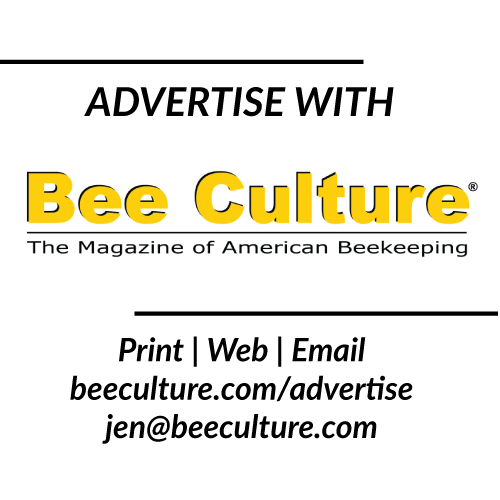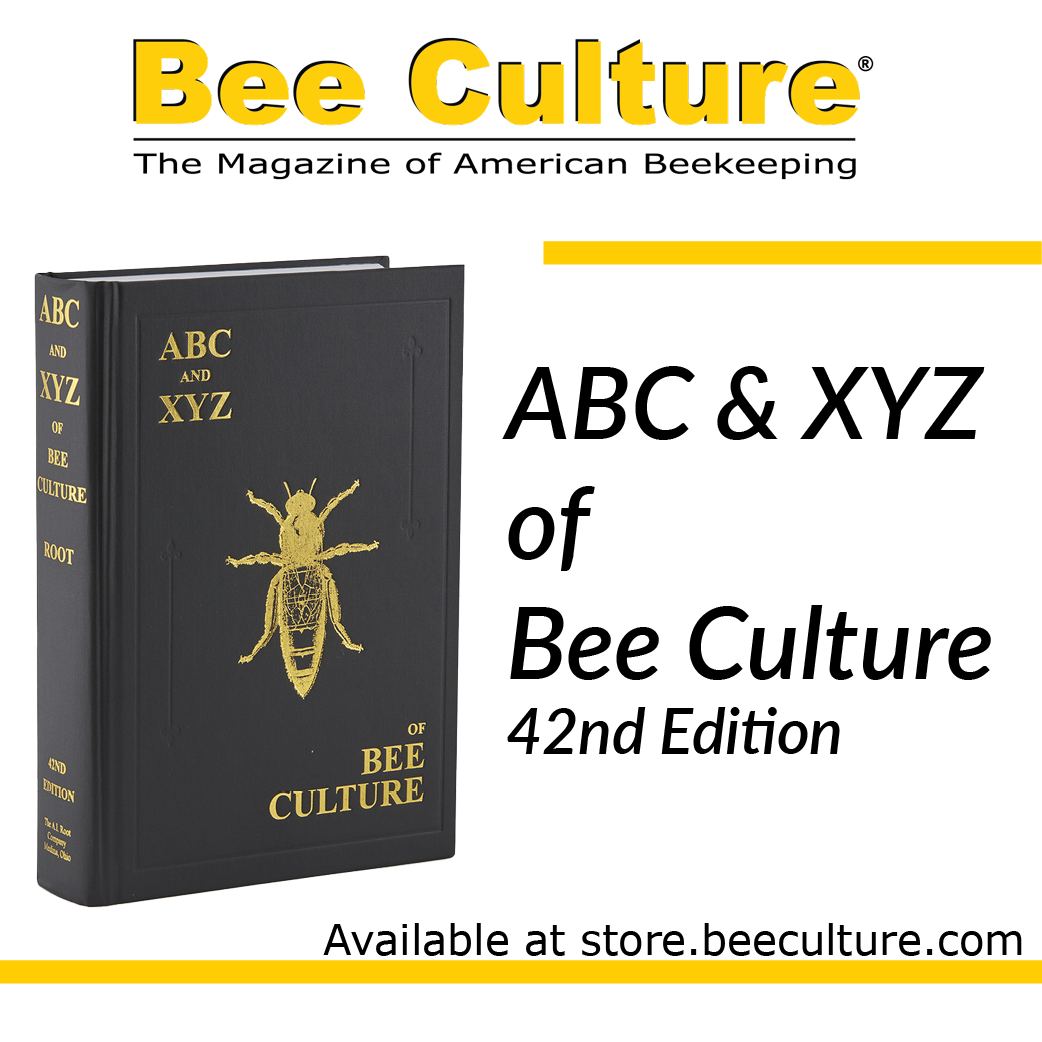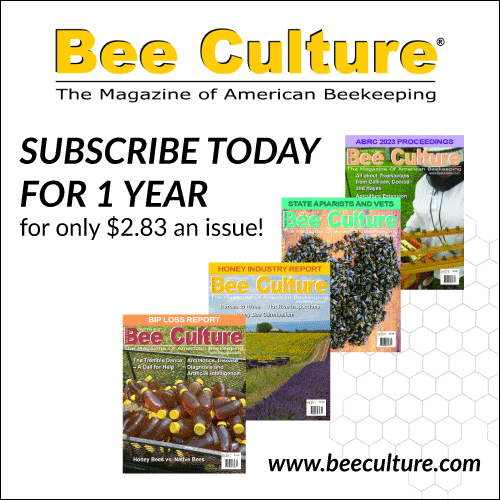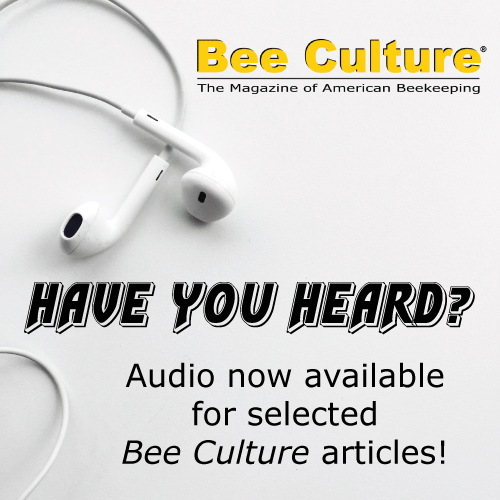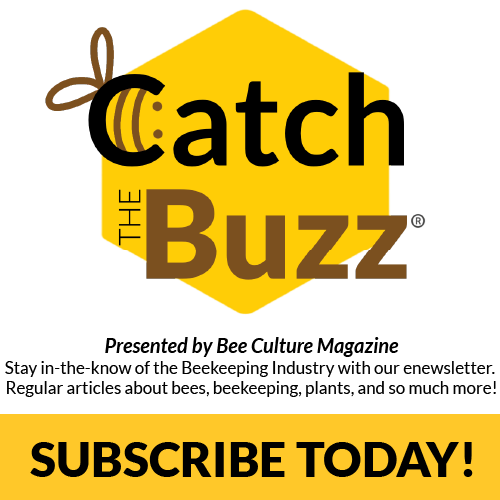Click Here if you listened. We’d love to know what you think. There is even a spot for feedback!
Read along below!
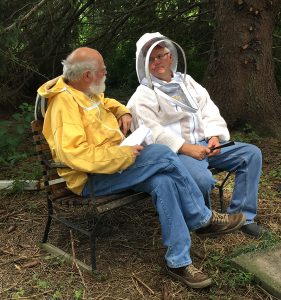 A Conversation with Kim Flottum, Part 2
A Conversation with Kim Flottum, Part 2
Retired, Longtime Bee Culture Magazine Editor
By: James E. Tew
Last Month
Bee Culture readers, last month, Kim told us the story of his early years as editor of this magazine. Editor Jerry, the current manager of Bee Culture, stopped the first interview just after Kim introduced Charlie Gibbons, who was the White House beekeeper during the Obama administration years. This article, A Conversation with Kim Flottum (Part 2) picks up at that point…
Kim: When Michelle Obama said she wanted a garden out back, one of the people that worked there said, “If you’re going to have a garden, you got to have bees and I know a beekeeper who works here.”
They went and tapped on Charlie’s shoulder and said, “We need a beehive for the White House organic garden.” The elected people who lived in the White House had a dog and Charlie put the beehive where you would expect it – on the ground. Every time the dog came out, he would go sniff the entrance. I don’t know if the dog ever got stung, but people thought it was probably not a good idea, so they made an eight foot tower to put the beehive on top of by the organic garden. When Charlie went to work bees, he had to climb a stepladder, but that was okay.
I wasn’t the only person that got invited there to work with the bees. Quite a few of the commercial and business beekeepers in the U.S. also got to come and visit and look and talk. That worked well.
Then not long after I started, three, four, five years, I got an article from a guy in England, and it was, How We Stop Swarms in England. The article was very British, very, very British. I liked it. The information was basic, but the presentation and how he used words wasn’t basic at all. I published it and I got to know the author. The author’s name was Peter. You met Peter when you were there.
Jim: I did. Peter Smith.
Kim: Then I got invited to my first National Honey Show in London. I was the speaker. The way the room was set up, all the chairs in the back, empty space right in front of the stage, the stage up above, and the speaker was over here on the right, a screen, standard lecture hall. I was looking at it because I was going to be next. “Where’s the steps? How steep are they? Where’s my talk? Everything’s set up.” Peter was what? Nine feet tall?
Jim: Yes, he was a tall man.
Kim: This big, tall guy (Peter Smith) comes over there and, in British English, he says, “How do you do?” I looked up at him and he says, “You published an article of mine, thank you very much.” Kathy and I got to know Peter. When the meeting was over, he drove us around a little bit of the part of town we were in. Over the years we got invited to his place and to his meeting several times.
At that meeting, Peter introduced me to Jeremy Burbidge who runs Northern Bee Books. Now, I had an international publisher contact. He published books and he published a bee magazine. We put our heads together and it turns out we were a lot more alike than not – in terms of being a publisher and what people thought. We got along really well. I got to spread Bee Culture’s influence pretty much across England and that worked. He got to spread UK beekeeping across the U.S. and that worked well. I got to go over there a bunch of times.
He lives way north in England, but he has a Summer house as far south as you can get and still be in England and not have wet feet. That’s how far south he lives. He lived less than a couple miles from… who was that monk in England?
Interviewer: Brother Adam?
Kim: Yes, Brother Adam – at Buckfast Abbey. You could almost see it (Buckfast Abbey) from his place. He was a little bit west of there, but it was that close.
Anyway, coming back to the U.S., I still was doing a fair amount of traveling and speaking. Almost all of this is because nobody else wanted it. I’m just one of the available ones to do this, so I guess I had nothing else to do.
Jim: You were the president during some dark times in the Ohio State Beekeepers Association with Africanized bees and predaceous mite introductions.
Kim: Thank you. I was. Africanized bees and mite introductions were bad.
Jim: It was a difficult time to be an officer in a bee group.
Kim: I had a good experience with a reporter asking about Africanized bees. The first Africanized bees in the U.S. were still very new when I got a call from a reporter at the New York Times about Africanized Killer Bees in the U.S. I had talked to this reporter before which is why she called me because I’m the only beekeeper she knew. We talked and I tried to calm her down, and I think I did a little bit. The story that came out wasn’t outright panic, but it was, “Oh my God, are we going to die? Are we going to die?” sort of thing.
A while later, she had a story in the New York Times about Charlie Gibbons, the White House’s beekeeper. By the way, this is how I met Charlie. I said, “I got to get ahold of her (the New York Times reporter).” I called her up and she said, “I can’t tell you that it’s the president.” I said, “You owe me a story,” so, she gave me Charlie’s name. That was it, just his name. No address. No phone number. I went to my subscription person, and I said, “Do we, by any chance, have a subscriber living in the Washington, DC, Maryland area, named Charlie Gibbons?”
She looked and she said, “Yes, we do.” I said, “Do we have a phone number?” My subscription person replied, “Yes, we do.” I called him up. He’d taken the day off to go to the doctor. I called up and suddenly I’m talking to the president’s beekeeper. How cool is that? That’s how I met the White House’s beekeeper who I discussed earlier.
Jim: You did that because of the Bee Culture subscription contact?
Kim: Yes.
Jim: The subscription address and phone number?
Kim: Yes. That got me in a lot of doors over the years. That got me in doors for two reasons. People were scared of what I would say in the magazine. I’m glad they didn’t know that I was more scared than they were. I would never say anything, and that procedure worked fairly well.
Secondly, beekeeping events started to wind down, in terms of the industry settling down over Africanized honey bees and Varroa mites. The conflict over the honey board eased but then adulterated honey became a prominent national issue. To this day, that adulterated honey challenge hasn’t gone away at all. I’m glad I’m not in the middle of that honey war because that’s not going to go away.
I saw an ad just this week selling honey for a dollar per pound in a 50-gallon barrel. I need to say it wasn’t U.S. honey. It was foreign honey. That’s what U.S. honey producers are up against right now and that’s not going to get any better with inflation and all the things being what they’re going to be.
All things considered, I got out of this editor position at just about the right time in terms of domestic problems, and in terms of international problems. Personal problems? I never had any. A couple beekeepers, occasionally, would confront me with an issue, but by the time I wound down at Root, I had things where I wanted the magazine to be. I had the staff and I had the resources. I’ve made a lot of contacts over the years. Jim, I bet you I could go get a bee writer in twenty different countries today to write an article.
If there’s something going on in Bulgaria, I know the guy and I can say, I established those contacts, and that meant, when you want to know something, who do you know, then call Kim. That worked well and still works to a large degree.
Jim: You routinely had large meetings in Medina featuring well-known beekeeping authorities.
Kim: Well, yes, we usually had a good crowd. We did an Ohio state meeting there and we had monthly meetings and we had two beeyards, and we had a lot going on in the Medina yard because John Root (the President of the Root Company then) supported it. John Root was the last beekeeping administrator at the Root Company. Everything that I did bees, he was behind 100%. He would say, “Do you need a little more?”
Yes. We had a lot of club members. They were from not just Medina, they were from Northeast Ohio, the whole corner of Ohio. One of them was a guy named Jeff Ott, who lived up in the Cleveland area or someplace. He got to know me. We talked and then a little bit later he asked, do you need any articles on anything here or maybe someplace else? Pretty soon he was writing routinely for me. He had a day job and a situation where he could take a week off and go to Mexico and see what was going on with the bees there. He went to Colorado. He went to Mexico. He did a lot of traveling that I couldn’t or didn’t want to do.
Then he got a job in Colorado. When he moved there, he still wrote for me but that tapered off because his job got busy. A couple years later, about three or four years ago, he came back to visit his family who still lives here. He came into my office, and he said, “This is what I’m doing. How would you like to do a podcast?” I just looked at him and I said, “Well, what’s a podcast?” Because I had no idea. He took the time and the energy and the resources and taught me the basics of producing a podcast. The podcasts are named Beekeeping Today podcast and Honey Bee Obscura.
We figured it out between the two of us. He knew mostly all the things you can’t see it, the microphones and the headsets and the wires. He knew all the electronic stuff, and what was being recorded, how to get it recorded and transcribed and on the web. He knew all of that. It helped that he is an excellent beekeeper. I knew the beekeepers. I wasn’t sure what a microphone was when I started this project. He got me familiar with that. Now, I’m capable electronically. That’s about it. Capable.
Jim: Yes. I agree with you on that.
Kim: Between the two of us put together, he knew how, and I knew who. This project has been a success. I saw this building and growing. The magazine was doing fine. It was time for me to retire from the Root Company.
At the time, I was over 70 and I needed to sit down. I spent a year looking for someone to replace me. I found three people with whom I was comfortable. They were sharp, intelligent, articulate and nonconfrontational. None of them would have caused a problem. Jerry Hayes was selected. I didn’t even get the offer out of my mouth before he said, “Yes, I want it. When can I start?” He’s the Bee Culture editor now.
He just stepped right in. He came in and spent a year with me at the company. I was able to show him about a third of what I know. Looking back, I missed so much stuff when telling him how to get this job done. He’s had to learn the hard way, but now he’s in charge. Once in a while, I’ll offer an article or a piece of advice or something, but now he’s in charge.

Figure 3. An acknowledgment of Kim’s bee industry successes.
Kim: So, I’m still involved in the podcast, but I no longer travel to meetings. I haven’t been on an airplane in three years, and that’s just fine with me. In fact, I won’t even drive to a meeting. I’ll do Zoom if people want. I’ve got probably 200 talks on the computer behind me, and I pick a subject. I’m good to go in most cases.
Now I’m here at home and I’m going through this lung thing that’s causing me a bunch of problems. The medical theory is that it’s going to go away. They’re going to fix it, and I’m going to be back to normal. I’m not a betting man, but here I am – betting.
Jim: [laughs] I’m sure you are.
Kim: No other choice.
Jim: How old a man are you, Kim?
Kim: 76. Time flies.
Jim: Well, that’s not old.
Kim: Okay? Why doesn’t it feel that way?
Jim: Kim, you’ve given a good overview, but you can’t just list everything that happened. How many years did you work for the Root Company?
Kim: I started in 1986 and I quit in 2020. That would be 34 years.
Jim: You did videos, you taught short courses, you developed a pollinator garden. In fact, you had a dynamic pollinator garden layout. You even developed a second magazine.
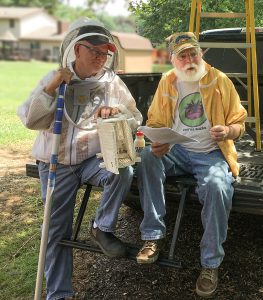
Figure 2. Jim Tew and Kim Flottum capturing footage for a video session of the Kim & Jim beekeeping video series.
Kim: Yes. You and I, all things considered, have been so far ahead of the electronic distribution of material in this industry than anybody I can think of. We did the Kim and Jim Show, and we did instructional videos. The one thing you’ve done that I haven’t done is initiate a YouTube channel. That’s the only thing I haven’t done. We’ve done everything else. We’ve written stories and we’ve written books. Kathy, my coworker, and wife, went to a bunch of national meetings doing the – what do you call it?
Jim: “Facebook Live.”
Kim: Facebook Live. Right. We went to meetings and talked to all the vendors and two years later, the vendors still came up, when they’d see me and say, “When you did that Facebook video at the Federation meeting, people still talk about that, so you made a splash.” It was because I had good people around me that knew more than I do and good people around me who wanted to help. We accomplished a lot in this industry that I say carefully, maybe now some of the people are beginning to catch up with.
Jim: Yes. You don’t stay ahead if you don’t keep racing. Even so, after a while, the race has to end.
Kim: What else did we do?
Jim: Well Kim, you and I had a car wreck on the way to a bee meeting.
Kim: Yes. We did. Almost a really bad one.

Figure 5. Jim Tew and Kim Flottum at one of many, many bee meetings.
Jim: Yes. We were going to an Ohio Farm Bureau Commodity meeting, as I recall and, at 65 mph, we got broadsided, you and me. Kim, we missed that meeting. (It was not our fault. Chuckles.)
Kim: We’ve had a lot of calamities together, but I clearly remember that one.
Jim: There’s just so many things. You’ve mentioned Kathy several times. She’s been an excellent coworker and a supportive wife for a long time for you. She should certainly be acknowledged in your successes. She was an integral part of the evolution of Bee Culture, too. You mentioned earlier that you started a second magazine, Beekeeping, Your First Three Years.
Kim: Yes, Kathy was fundamental to the magazine and to my career. That second magazine lasted, I want to say, five or six years. It hit during an economic downturn period that I had nothing to do with nor the industry had anything to do with. Unfortunately, it had to be dropped. If you have a copy hidden somewhere, keep it because there aren’t any more.
Jim: It was a useful magazine that was enjoyable to read. Kim, you published a lot of books for the Root Company, and you published books that you authored.
Kim: Yes, I have. If you had told me in 1965, I was going to publish a book – any book, it’d take me 20 minutes to get up off the floor from laughing. I began to see the value of having not a permanent voice, but a voice that had almost all the facts in a book. Not everything, because tomorrow something’s going to change, and next week something else’s going to change. Most of what’s in my book was true ten years ago and twenty years ago, and it’ll be true 20 years from now and that’s what I wanted to produce.
One of the times I was with Dr. Morse, (Dr. Roger Morse, Beekeeping Professor, Cornell University) he had a big office with a big desk. He sat on one side of the desk and there was a bookshelf behind him that went almost to the ceiling. We were sitting chatting and he turned around and said, “You need a new one, ABC.” The current edition, at the time, was like 11 years old. It hadn’t been revised in a while.
John Root and his predecessors, his father and his father’s brother had a schedule where they edited about a third of ABC every three years. They picked the oldest stuff and replaced it and left the rest of it alone. Well, I hadn’t been there three years yet, so Roger said, “Let’s do this.” Do what I asked? “Let’s rewrite this book.” He did 75% of it all new. I did maybe 20%. Then he pulled in a lot of people, and I pulled in some people. Roger did a lot, and we came out with a new ABC, that was a hit and a half, but the cover looked just like the old ones.
A few years later, Shim (Dr. H. Shimanuki, USDA ARS bee scientist) came to me and he said, “Are you ever going to do this book again?” I said, “No, you are.” He said, “I’ll be back in a month with a draft.” He was pretty much on time getting it back to me. I looked at the cover and I said, we are never, ever going to put this traditional cover on ABC again. I had a picture of a beekeeper, standing out by a beehive. This new version was to have that color picture, a shiny cover. That’s the only one ever and probably the only one that will ever have a color cover.
Jim: [laughs]
Kim: Dr. Keith Delaplane (bee scientist, the University of Georgia) oversaw the editing of the current ABC, and he got ABC where I wanted it to be. He is a good scientist and a good beekeeper. He has good people working for him. He edited the ABC I wanted. I didn’t want a science textbook and I didn’t want a how-to-stop swarming book. I added a bunch of stuff from people that nobody knows or knew then. I think the last edition of ABC was pretty good.
Jim: Right, that last book was a good publication. It looked good.
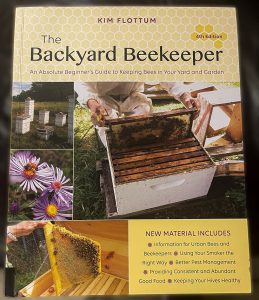
Figure 4. The cover of Kim’s popular beekeeping text, The Backyard Beekeeper 4th Edition
Kim: Then among the other books I wrote, was Backyard Beekeeper, modeled after several, but not a lot, like several books already out there. Early this past Summer, I finished the fifth edition of Backyard Beekeeper, that’ll be out in February 2024. Then, there was another one, The Honey Handbook, and that just focused on how to get as much honey out of a bee as you can. The last one I did was, Common Sense Natural Beekeeping, which was taking everything that’s good for the bee and getting rid of everything that wasn’t good for the bee. It turned out to be mostly natural, but not quite common-sense beekeeping.
Jim: I don’t know. There must be one, but I don’t know who else has had five-issue updates of the same beekeeping book. You know, a book that wasn’t like ABC or the Hive and the Honey Bee. That’s impressive, Kim.
Kim: Yes. Now, the Beekeeping Today and Honey Bee Obscura podcast projects have been entertaining for me. We presently have generous sponsors for the productions and Jeff does a great job editing the audio and posting the segments on the web. I’m enjoying working on them.
Jim: Kim, this review has truly been an educational process for me. There’s no practical way to compress all your decades into a couple of simple magazine articles, but we surely tried. I have enjoyed listening to your experiences. Thanks for your time and memories.
Dr. James E. Tew
Emeritus Faculty, Entomology
The Ohio State University
tewbee2@gmail.com
Co-Host, Honey Bee
Obscura Podcast
www.honeybeeobscura.com

